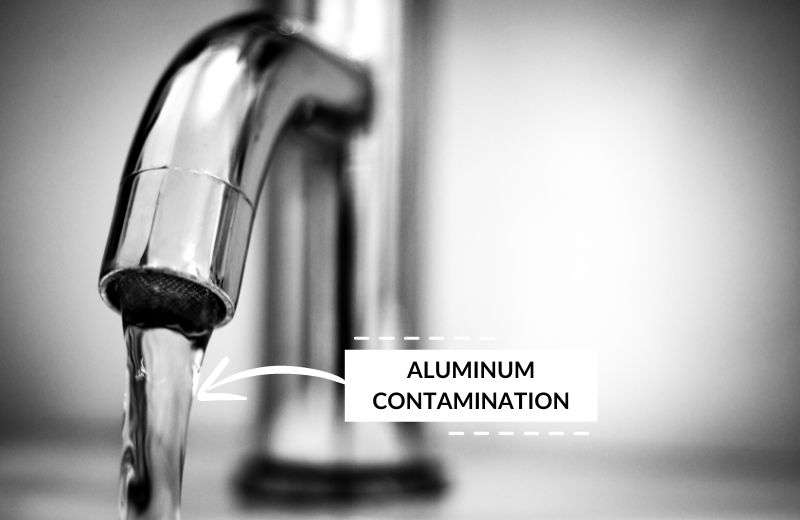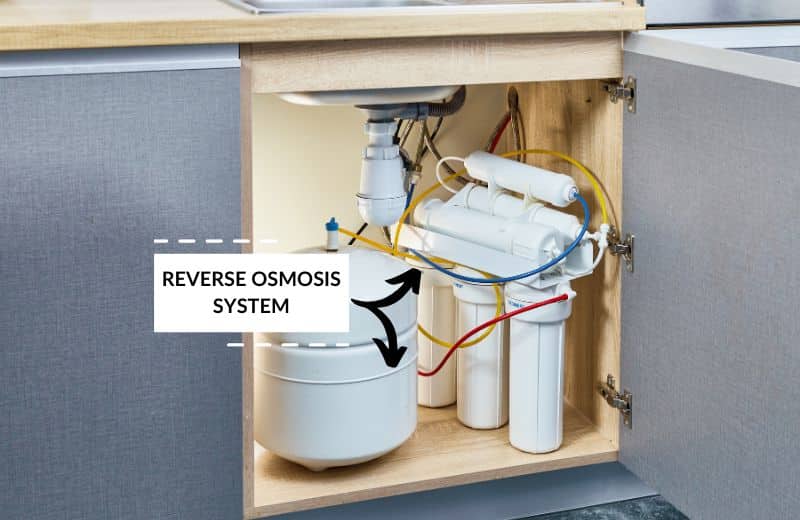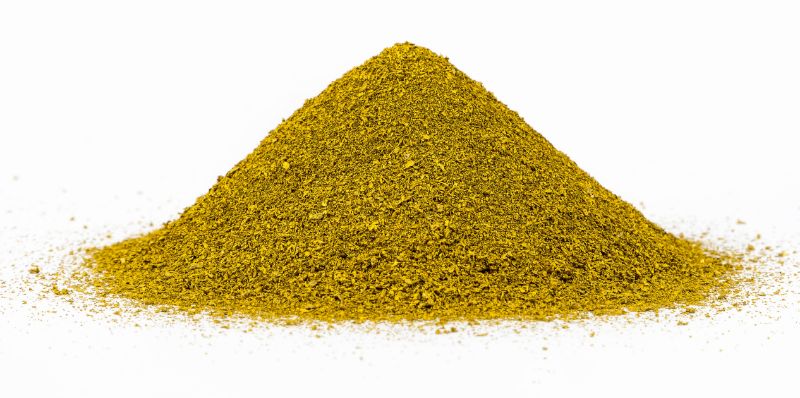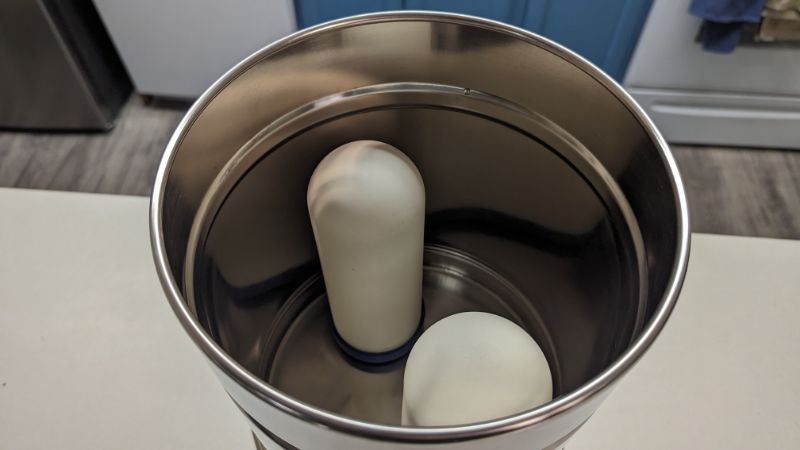Aluminum is a metal that’s found naturally in low concentrations in water sources. It’s also often added to water due to the use of aluminum-based coagulants in water treatment plants.
In this guide, we’ve shared a quick overview of aluminum and discussed the 5 best methods to remove aluminum from water.
📌 Key Takeaways:
- Aluminum is a heavy metal that occurs naturally in the environment and also enters water due to human activity.
- The best methods of removing aluminum from water are reverse osmosis and anion exchange.
- Other methods that can reduce aluminum are KDF-55 filtration, water distillation, and ceramic filtration.
Table of Contents
💡 What Is Aluminum?
Aluminum is a naturally occurring metal that’s present in rocks, soils, surface waters, and groundwater supplies. It’s naturally present in low concentrations in water (the exact concentration depends on geological factors and human activities). It’s also present in food additives and drugs.
Aluminum in water is regulated by the United States Environmental Protection Agency (EPA), which has recommended a Secondary Maximum Contaminant Level (SMCL) of 0.05–0.2 mg/L for this contaminant.
❓ Is Aluminum in Water Harmful?
In general, low levels of aluminum in water aren’t considered harmful to human health. Many foods and drinks actually contain small amounts of aluminum, and our bodies can handle them with no major issues.
However, excess aluminum intake – such as drinking water with high concentrations of aluminum – may be dangerous to health. Essentially, the risks associated with aluminum in drinking water depend on the concentrations present.

🤔 How Does Aluminum Get Into Drinking Water?
Aluminum is present naturally in rocks and soils, which means that surface water and groundwater sources often have a low aluminum content. As water flows over or seeps through rocks containing aluminum, aluminum ions leach into the water, increasing its aluminum content.
Aluminum can also be introduced into water due to industrial processes and human activities. For instance, aluminum may enter water as a result of:
- The use of aluminum-based coagulants (like aluminum sulfate or alum) in water treatment plants, which leaves residual aluminum in water.
- Acid rain, which is caused by air pollution and can cause aluminum to leach from soils and rocks.
- Mining and industrial activities.
- Contact with aluminum pipes (often used in old plumbing systems) and containers (such as aluminum-based cooking utensils or aluminum water bottles).
📑 Possible Health Effects of Aluminum
There are several possible health effects of aluminum in water, but most sources – including the CDC – say that ingesting low levels of this metal in your drinking water shouldn’t have harmful effects.
One of the most researched possible effects of aluminum in tap water is Alzheimer’s disease. One 8-year follow-up study found that subjects exposed to aluminum concentration greater than 0.1 mg/l were at risk of dementia, concluding that aluminum in drinking water is a risk factor for Alzheimer’s disease.
✅ How to Remove Aluminum from Tap Water
Here are the most effective methods of aluminum removal to consider using at home:
1) Reverse Osmosis Systems
Reverse osmosis is the most effective way to remove dissolved aluminum (which your water is likely to have if it’s slightly acidic or slightly alkaline). You can buy a reverse osmosis system to install under your kitchen sink or on your kitchen countertop.
RO is a popular water treatment method that’s used to purify drinking water supplies. Reverse osmosis membranes can remove up to 98% of aluminum, as well as a whole host of other contaminants, like heavy metals, chemicals, and some microorganisms.
Many manufacturers of RO systems share test results that show you which contaminants the system has been tested to remove, and to what percentage. This should help you easily identify an RO system’s ability to reduce aluminum compounds and compare the system’s performance to
Reverse osmosis water filters are popular because they purify water and remove more contaminants than any other water treatment process. However, these systems also remove healthy minerals, and they waste water during the membrane separation process.

2) Anion Exchange
Anion exchange is a type of ion exchange that’s capable of reducing aluminum in drinking water. In this process, negatively charged ions, called anions, are exchanged for other anions present in the water.
The negatively charged aluminum ions are attracted to, and bind to, the anion exchange resin, and other anions of the same charge (which were originally attached to the resin) are released to balance out the water’s charge. The treated water that leaves the anion exchange system is now free of aluminum.
Some carbon-based water filters, such as those used in water filter pitchers, use a blend of carbon and ion exchange resins that may be able to reduce aluminum in water. When the resin becomes exhausted, the filter must be replaced.
Anion exchange resin may also be used in regenerating systems that replenish the used ions in the resin, usually with a strong acid solution (such as hydrochloric acid), but these systems aren’t used in domestic applications.
3) KDF-55 Filters
KDF-55 filter media is commonly used in water filters and purifiers and is specially designed to target heavy metals in drinking water.
This media is a combination of copper and zinc granules, which instigate an oxidation-reduction (redox) reaction that can effectively remove certain contaminants, including aluminum, from water.
During this redox reaction, electrons are transferred between aluminum contaminants and the KDF-55 media. The copper and zinc, which act as catalysts in the media, undergo oxidation and lose electrons. Meanwhile, the aluminum ions in the water are attracted to the KDF-55 media, which pulls them out of the water supply.
KDF-55 filters also provide physical filtration, capturing large particles and preventing them from passing through the filter pores.
You can find KDF-55 filters in various filter applications, including inline fridge filters, under-sink systems, shower filters, countertop filters, and whole home tank- and cartridge-based systems.

4) Water Distillation
Water distillation is another method of water purification that’s capable of removing aluminum and up to 99.99% of all tap water impurities.
The process of distilling water involves boiling it until it evaporates, then transporting the water vapor to a separate container, where it condenses back into liquid form. The impurities, including aluminum, remain in the boiling chamber and can be removed when you clean the system.
Most water distillers have a 1-2 gallon capacity and are designed to sit on your kitchen countertop.
The great thing about water distillers is that they remove a whole range of drinking water harmful contaminants. However, like reverse osmosis, they also remove healthy, taste-enhancing minerals, leaving water tasting a bit flat. The distillation process also takes forever – up to 5 hours to produce a 1-gallon batch of distilled water.
5) Ceramic Filters
Finally, ceramic filters are worth considering if you’re looking for a solution for removing aluminum in particulate form. These filters are most commonly found in countertop gravity-fed water filtration systems.
Ceramic filters have a porous structure that consists of tiny channels and pores. When water flows through a ceramic filter, physical filtration occurs, and the small pores act as barriers, preventing larger particles from passing through.
Some forms of aluminum particulates are trapped in the filter media, while water molecules can pass through.
Some ceramic filters contain an activated carbon core. While activated carbon isn’t usually effective enough to be used alone to remove the majority of aluminum, it can be used to enhance the aluminum reduction abilities of other filter media.
*Note that ceramic filters can’t be used to remove dissolved aluminum, which is small enough to pass through the filter’s pores.

❔ FAQ
How do I know if a water filter can remove aluminum?
The best way to know whether a water filter is capable of removing aluminum is to check the manufacturer’s test data. This should tell you how much aluminum the filter has been tested and proven to remove. If test data isn’t available online, contact the manufacturer and ask for this information to be sent to you via email.
Is there an NSF certification for aluminum?
No, there isn’t a dedicated NSF certification that water filters can obtain if they successfully remove aluminum. However, a water treatment system might be certified for its performance, which includes the reduction of aluminum. For instance, a reverse osmosis system might have an NSF 58 performance for the RO membrane’s ability to remove a variety of contaminants, including aluminum.
Does Brita filter remove aluminum?
No, Brita filters aren’t advertised to remove aluminum. The filters may reduce aluminum somewhat, but they’re not intended to offer dedicated aluminum removal.
Do carbon filters remove aluminum?
We’ve seen some sources that say carbon filtration is a good way to reduce aluminum in drinking water, but we don’t recommend carbon filters alone for this purpose. On average, a carbon water filter removes around 30% of aluminum from water. You’ll need a more comprehensive filter that blends carbon with other media to remove a larger percentage of this contaminant.
Will boiling water get rid of aluminum?
No. You can’t boil water to reduce its aluminum concentration. Boiling water will simply cause some of the water to evaporate, meaning that your tap water aluminum content is higher per gallon of water. If you want to reduce your aluminum exposure, you’ll need to invest in a capable water filter system.

Thank you for providing your experience with water additives and treatments. It is also amazing that the information is available without cost to those who want to provide their family with healthy options. With better health, we can be more productive in our contributions to society.
You are welcome! Thanks for your feedback and I’m happy you found the article informative